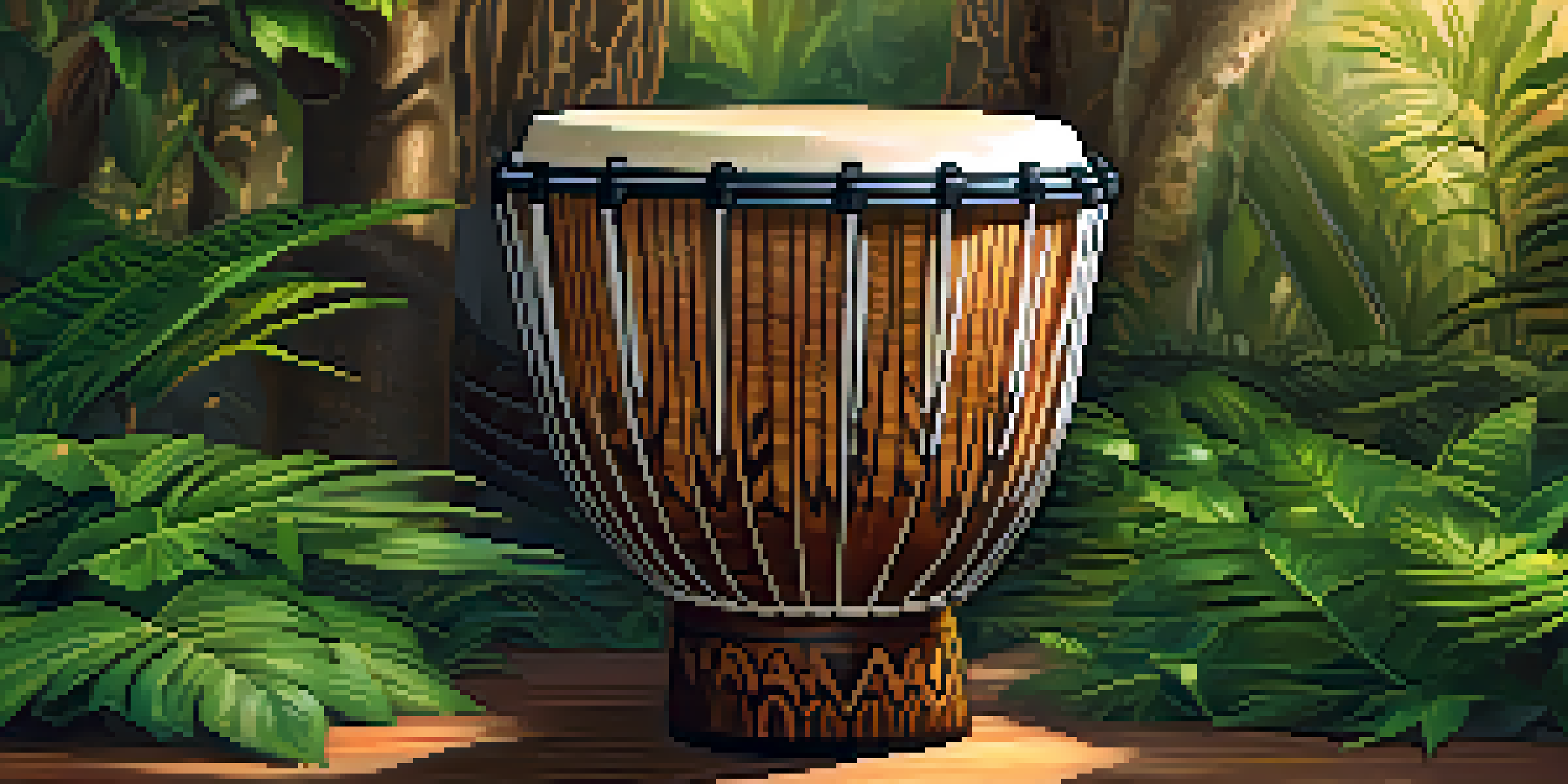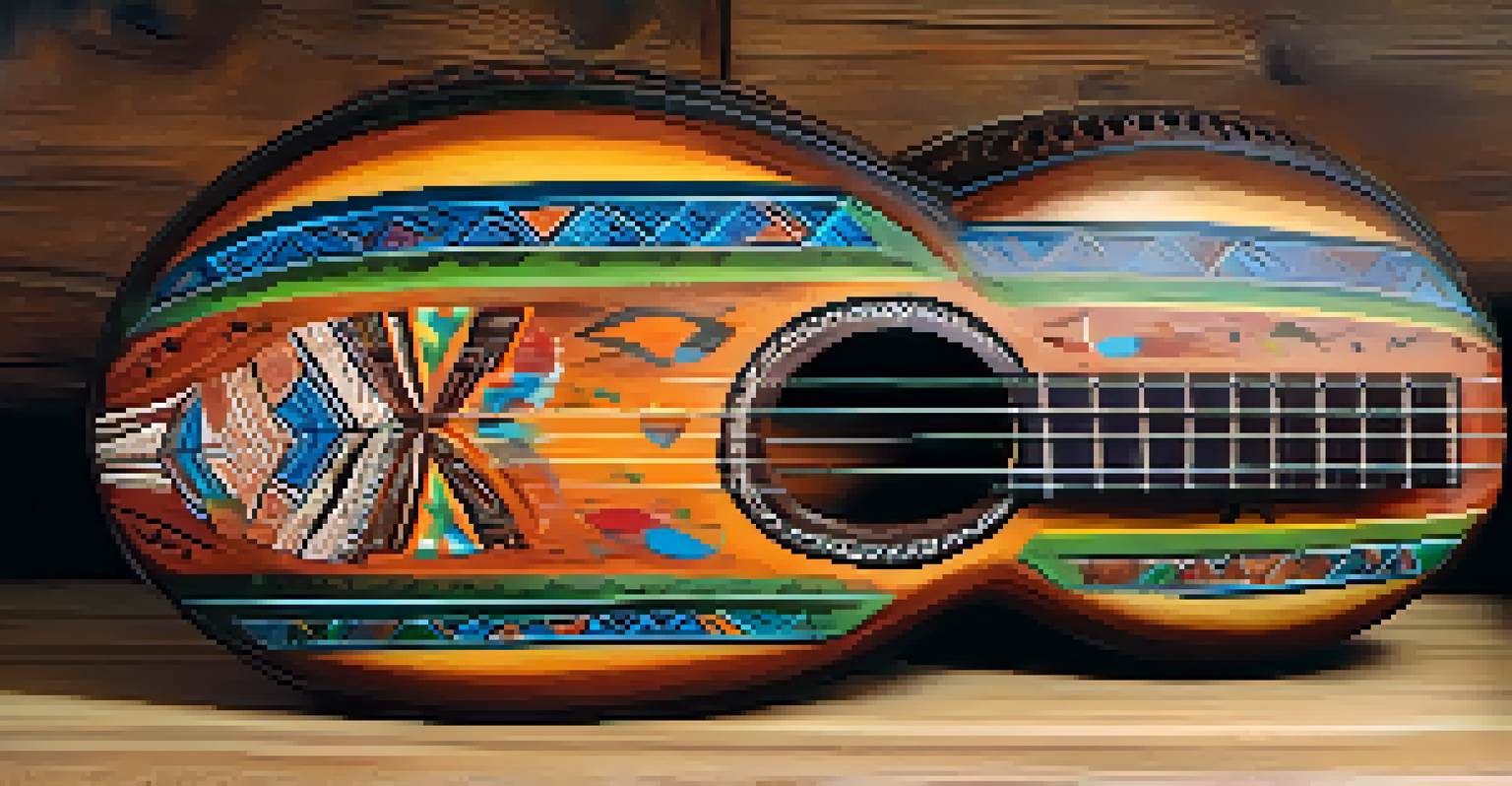Regional Variations in Carved Musical Instruments Worldwide

The Art of Carving: A Global Tradition
Carved musical instruments have been part of human culture for centuries, representing not just sound but artistry. Each region brings its unique flair to the carving process, reflecting local traditions and available materials. From Africa to Asia, the art of carving has evolved, influenced by cultural practices and the environment.
Music is the shorthand of emotion.
For example, many Indigenous cultures in the Americas use wood from their local trees to create flutes and drums, carving intricate designs that tell stories and honor their heritage. This reflects a deep connection between the instrument and the community's identity. In contrast, Asian cultures might use bamboo or ivory, showcasing their resources and artistic expression.
These variations highlight how the same principle—music—can be expressed through different mediums and techniques worldwide. By embracing local materials and traditions, these instruments become not just tools of music but also carriers of cultural significance.
African Drums: The Heartbeat of Community
In Africa, carved drums hold a crucial place in community gatherings and rituals, serving as the heartbeat of social life. Instruments like the djembe and talking drum are not only crafted from wood but also infused with cultural meanings, often representing lineage, history, and spiritual beliefs. The intricate carvings often depict stories or symbols important to the community.

Each region in Africa boasts its own style; for instance, the djembe from West Africa is known for its hourglass shape and vibrant sound, while the ngoma drum has a flatter, wider body used in East Africa. The craftsmanship involved in carving these instruments is an art form passed down through generations, showcasing both skill and cultural significance.
Carving Reflects Cultural Heritage
The art of carving musical instruments is deeply intertwined with local traditions and materials, showcasing each region's unique cultural identity.
Moreover, drumming is often a communal activity, fostering unity and connection among people. The sound of these drums resonates with the heart and soul of the community, making them indispensable in celebrations, storytelling, and even healing practices.
Asian Stringed Instruments: Harmony and Detail
Moving to Asia, carved stringed instruments offer a glimpse into a world of harmony and intricate craftsmanship. Instruments such as the Chinese guqin and the Japanese shamisen are renowned for their beauty, both in sound and design. The delicate carvings on these instruments often reflect philosophical ideals, nature, or mythology.
The best way to predict the future is to create it.
For instance, the guqin, a seven-stringed zither, is traditionally crafted from fine woods, adorned with carvings that symbolize the connection between music and spirituality. Its design emphasizes simplicity and elegance, aligning with the Zen philosophy prevalent in Japanese culture. The shamisen, on the other hand, features bold and colorful designs that tell stories of Japan’s rich history.
These instruments are not just about producing music; they embody the cultural narratives and artistic expressions of their regions. The meticulous carving techniques used reflect a deep respect for tradition, allowing musicians to connect with their heritage through every note played.
European Woodwinds: Craftsmanship and Elegance
In Europe, carved woodwind instruments like the clarinet and flute showcase a blend of craftsmanship and musical precision. These instruments are often made from carefully selected woods, with intricate carvings that enhance their aesthetic appeal. The craftsmanship involved in creating these instruments is a blend of art and science, ensuring both beauty and functionality.
Take, for example, the wooden flute, which can feature elaborate carvings that not only make it visually striking but also affect its acoustics. Each carving can add an element of resonance, making the instrument uniquely expressive. The history of these instruments is rich, often tied to the royal courts and classical music traditions that emphasize elegance and refinement.
Community and Connection Through Drums
In Africa, carved drums serve as vital symbols of community, representing social life and cultural history through their intricate designs.
Moreover, European woodwinds have influenced the global music scene, with their designs and sounds permeating various musical genres. The artistry in their creation is a testament to the cultural importance of music in European history, making these carved instruments treasures of heritage.
Indigenous Instruments: A Deep Connection to Nature
Indigenous cultures around the world have created unique carved instruments that reflect their deep connection to nature and spirituality. Instruments like the Australian didgeridoo and the Native American flute are not only musical tools but also sacred objects that carry ancestral stories. The carvings on these instruments often depict elements of nature, animal spirits, or cultural symbols.
For instance, the didgeridoo is traditionally made from eucalyptus wood, hollowed out by termites, and is often beautifully decorated with intricate designs that represent the land and its stories. The Native American flute, often carved from softwoods, features designs that honor the earth and its resources, emphasizing the importance of sustainability.
These instruments are integral to cultural ceremonies and storytelling, serving as a bridge between the past and present. Their unique sounds resonate with the rhythms of nature, creating a musical language that connects communities to their environment and heritage.
Latin American Rhythm: Carved Instruments of Celebration
In Latin America, carved instruments like marimbas and charangos play a vital role in cultural celebrations, embodying the spirit of festivity and community. These instruments are often crafted from local woods, with vibrant carvings that reflect the region's colorful culture. The marimba, for example, features wooden bars that produce rich melodies, while its body is often adorned with intricate designs.
The charango, a small string instrument traditionally made from the shell of an armadillo, showcases both creativity and resourcefulness. Its carvings often tell stories of the Andes, connecting musicians to their roots and cultural narratives. These instruments are not just for music; they are a celebration of life and heritage.
Innovation Meets Tradition in Crafting
Modern advancements in carving techniques are blending traditional methods with eco-friendly practices, ensuring the sustainability of instrument making.
Through festivals, these carved instruments bring people together, creating a shared experience that transcends language. The rhythms and sounds of Latin American music, infused with the artistry of carving, serve as a reminder of the joy and unity found in musical expression.
Modern Innovations in Carving Techniques
Today, the art of carving musical instruments continues to evolve, blending traditional techniques with modern innovations. Craftsmen are exploring new materials, such as recycled woods and eco-friendly finishes, while still honoring the age-old methods passed down through generations. This fusion allows for the creation of instruments that not only sound beautiful but also promote sustainability.
Digital tools are also making their way into the crafting process, allowing for precision and creativity in design that was previously unattainable. While traditional hand-carving remains revered, these modern techniques enable artisans to push the boundaries of what is possible in instrument design. This evolution reflects a growing awareness of environmental issues and the desire to create instruments that are both functional and sustainable.

As a result, we see a new wave of musicians and craftsmen who are passionate about preserving cultural heritage while embracing innovation. This balance between tradition and modernity is key to keeping the art of instrument carving alive and relevant in today's world.